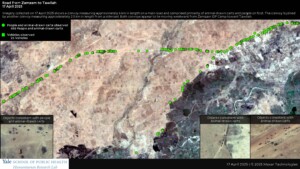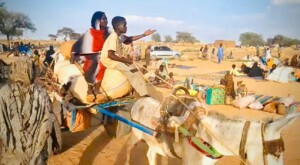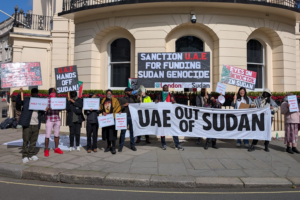Sudan OCHA bulletin 39: Severe food insecurity in non-government controlled areas
According to local aid organisations, people living in the non-government controlled areas of Blue Nile, South Kordofan, and western Jebel Marra are facing severe food insecurity.
The Office for the Coordination of Humanitarian Affairs (OCHA) in Sudan reports in its latest weekly bulletin that the Famine Early Warning Systems Network (FEWS NET) Food Security Outlook for August likewise reported that food insecurity among conflict-affected people in non-government controlled areas of South Kordofan, Blue Nile and areas of Jebel Marra is of great concern with crisis levels of acute food insecurity.
According to local aid organisations, people living in the non-government controlled areas of Blue Nile, South Kordofan, and western Jebel Marra are facing severe food insecurity.
The Office for the Coordination of Humanitarian Affairs (OCHA) in Sudan reports in its latest weekly bulletin that the Famine Early Warning Systems Network (FEWS NET) Food Security Outlook for August likewise reported that food insecurity among conflict-affected people in non-government controlled areas of South Kordofan, Blue Nile and areas of Jebel Marra is of great concern with crisis levels of acute food insecurity.
Lower than average rainfall that started late this season is expected to affect this year’s main harvest (October to December) and could also impact national production in 2016, according to FEWS NET.
Fighting between government forces and armed groups in Blue Nile, South Kordofan, and western Jebel Marra has led to widespread insecurity, disrupting cultivation and livelihood activities. Increased sorghum prices have further exacerbated the situation with prices rising by 290 percent in central South Kordofan and 585 percent in West Jebel Marra between June and July 2015
Access for aid organisations to these areas has largely been restricted, preventing assessments and provision of assistance. Nevertheless, partners continue to negotiate with authorities to gain access to these food insecure populations.
Unamid peacekeeper killed in North Darfur
On 27 September, a Unamid peacekeeper was killed and four others injured in an attack by unidentified men near North Darfur’s Mellit town. They were escorting a Unamid logistics convoy.
Between January and August 2015 there have been 131 security incidents in Darfur that have affected humanitarian workers and peacekeepers, including abductions, armed attacks, car jackings and crime. According to the UN Department of Peacekeeping Operations, as of 31 August there have been 222 fatalities among Unamid personnel since the establishment of the peacekeeping mission in 2007.
South Sudanese refugees in El Leri are living in poor conditions
According to the governmental Humanitarian Aid Commission (HAC) in South Kordofan, an estimated 5,400 South Sudanese refugees who arrived in El Leri locality in September are in need of humanitarian aid. Most of them are women and children who have taken refuge with the existing South Sudanese community in the area. Others have sought shelter in the nearby gold mine.
HAC and local authorities have distributed initial food supplies to the new arrivals. Last week, the South Kordofan Ministry of Health airlifted medical supplies to El Leri for the needs of around 2,000 people, including the South Sudanese refugee population, for one month.
A planned assessment mission with representatives from the World Food Programme (WFP), Unicef and HAC was unable to reach El Leri because of poor road conditions caused by heavy rains. However, WFP food stocks stand ready in El Obeid for dispatch to El Leri as soon as road conditions allow. The Sudanese Red Crescent Society in El Leri will assess the emergency shelter and household needs of the new refugee population.
Displaced in East Darfur concerned about school drop outs and lack of aid
During a hotline sensitisation mission to the area of El Mina El Bari area in East Darfur’s Ed Daein locality, displaced families expressed concern about the high drop out rates among their school-aged children. Apart from the problem of school fees, the children feel pressured to leave school and find jobs to help ease the financial demands on their families.
The displaced started arriving in the area in August 2013 when fighting erupted between Rizeigat and Ma’aliya tribesmen. Since that time, Unicef and WFP supported a school close to where the displaced families settled. The United Methodist Committee on Relief constructed classrooms and latrines, trained 11 teachers, and provided school kits to the school. Unicef and the state Ministry of Education initiated plans to build an additional school in the area and to actively monitor school drop outs.
More than 3.1 million of Sudan’s 7.9 million school-aged children (between 5 and 13 years) in Sudan are out of school, which is the highest rate in the Middle East and North Africa, according to a recent report by the Ministry of Education and Unicef.
Humanitarian Response Plan nearly 50 percent funded
Funding for the 2015 Sudan Humanitarian Response Plan (HRP) has reached 49 percent, equivalent to $503.5 million of the $1.04 billion requested. The recent increase in reported HRP funding is thanks to the $86 million donation, comprised of mixed food items worth $75 million, and $10 million cash, contributed by the US Agency for International Development (USAID) earlier in September.
The 2015 HRP targets 5.4 million people in need of emergency relief aid across 52 of the most severely affected localities. Although partners have reported significant progress towards target outcomes laid out in the HRP, with still one quarter left in the year much remains to be done. Access restrictions have placed further limitations on the humanitarian response capacity, particularly for operations in parts of South and West Kordofan, Blue Nile and Darfur’s Jebel Marra.
Read the full OCHA bulletin here











 and then
and then